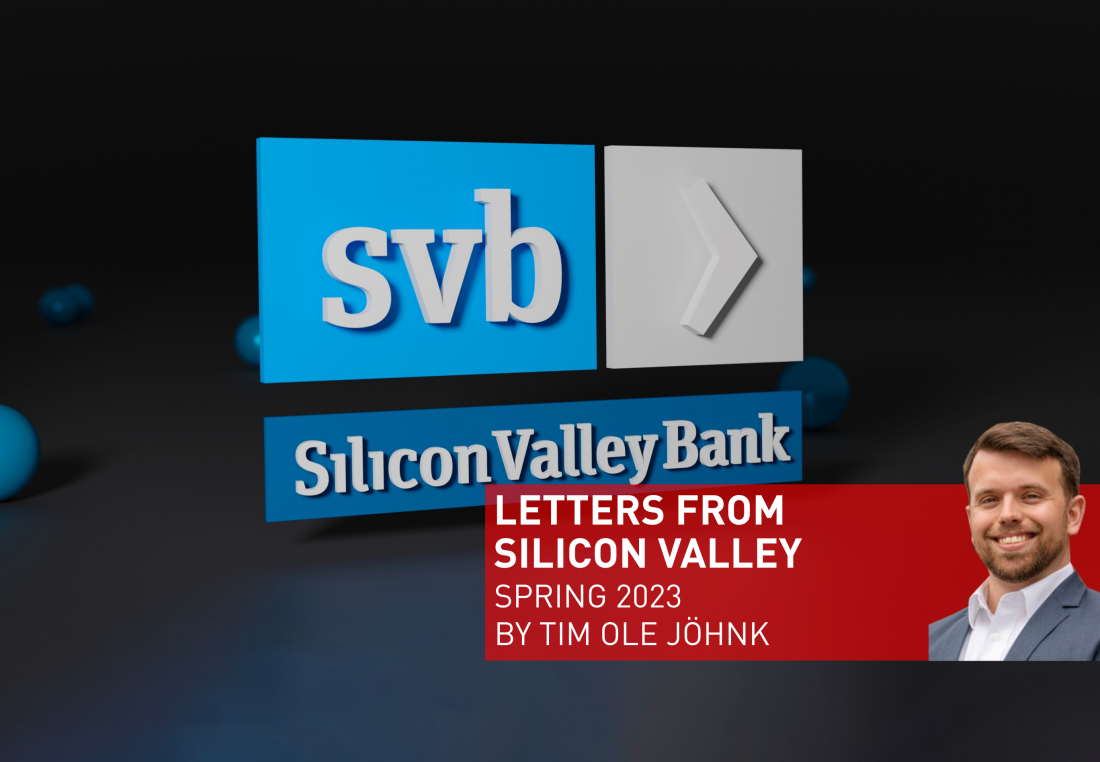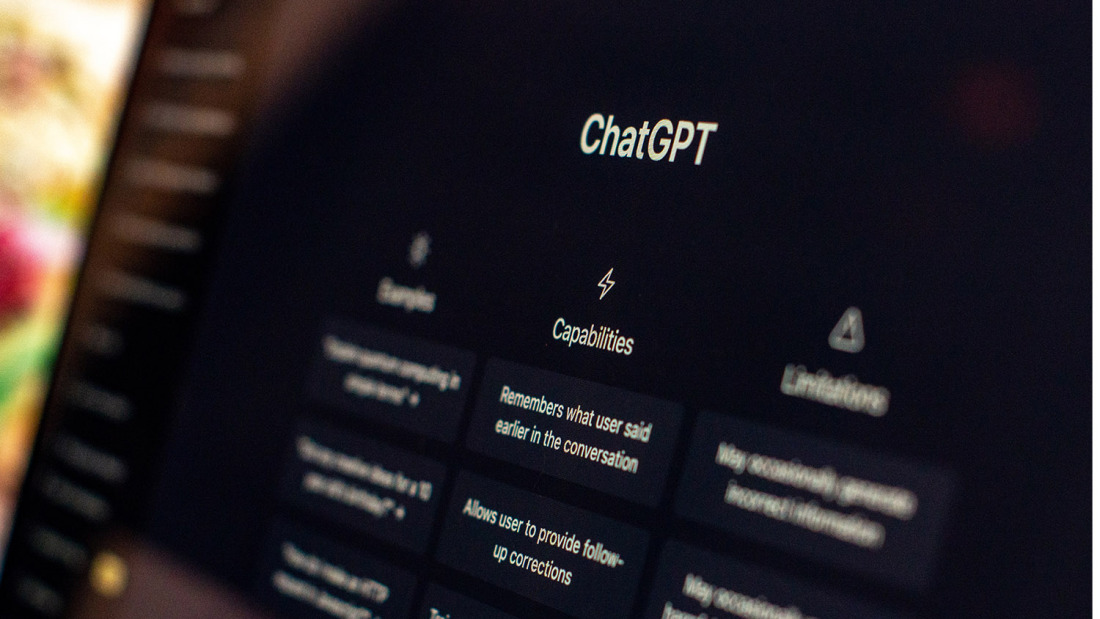Letters from Silicon Valley, Spring 2023 – One Bank Rocks the Tech World
Letters from ...Trends and technologies from the tech valley

What does the collapse of Silicon Valley Bank mean for tech start-ups in San Francisco? Our USA expert, Tim Ole Jöhnk, investigates. Also in our Spring letter: Chat GPT is conquering the world – but is it a sustainable business model?
Tim Ole Jöhnk, Director of the Northern Germany Innovation Office (NGIO), reports directly from the USA on the topics that have preoccupied Silicon Valley in recent days and weeks.
Silicon Valley Bank (SVB) has collapsed. How is the tech world reacting?

SVB's customers included around half of all the start-ups in the USA that have accessed venture capital loans and around 2,500 venture capital funds. It was the most important bank in Silicon Valley, with deposits totalling 180 billion dollars. For decades, start-ups could rely on the services provided by this bank, thanks to investors with deep pockets and a correspondingly brisk influx of fresh capital. In common with most of its competitors, SVB kept only a part of these deposits in ready cash, and used the rest to purchase long-term liabilities such as safe government bonds (but to a much greater extent than other banks). For as long as interest rates remained low, these bonds promised safe and moderate returns.
However, since 2022, the US Central Bank (the FED) has been steadily increasing its base rate to counter rising inflation. In May 2022, Sequioa Capital, the influential American venture capital firm, warned of challenging times ahead. Money was becoming more expensive, funds were finding it harder to find new investors and start-ups which had been accustomed to "burning" hundreds of thousands of dollars a day now suddenly had to tighten their belts. Companies increasingly had to tap into their own reserves instead of acquiring new capital. In addition, increases in the bank's base rate resulted in dramatic losses of value in government bonds. SVB had to sell off some of its government bonds, under less than ideal conditions, so it could make pay-outs to its customers. It made this news public on March 8th this year, including the need to raise capital. This triggered a panic in the tech sector. Companies and investment funds attempted to withdraw their money from SVB wholesale and transfer it to other financial institutions.
On Friday, March 10th, the Federal Deposit Insurance Corporation (FDIC) in the USA announced that it would take over SVB. However, the FDIC only provides insurance for deposits of under 250,000 USD. 96 percent of all SVB's customers had deposits that were significantly higher than this limit. This was a dramatic turn of events for many companies and start-ups.
For this reason, the FED also decided to intervene over the weekend. It provided emergency credit to ensure additional liquidity and permitted loans to be taken out against the nominal value of the government bonds held by SVB. SVB was not the only bank to find itself in difficulties: Signature Bank, Silvergate and First Republic Bank were also floundering. However, they are now in a position to provide money to their clients. At the same time, it is not a bank bailout, the SVB is history and the authorities are already looking for interested investors to buy up the bankrupt estate; investors in SV bank shares will go away empty-handed. And First Republic Bank is still stumbling, despite a more than 30 billion rescue package from other banks, many investors are withdrawing their deposits.
Even if this helpe reduce the first wave of panic, which spread like wildfire through the closely interconnected networks of Silicon Valley, and which some people regard as the flashpoint for the run on SVB, many companies cannot foresee how long they will remain solvent enough to pay salaries and cover their other obligations and how quickly the new aid packages will be forthcoming. Many companies are currently attempting to transfer their funds to other banks. Some tech billionaires have called for uncomplicated "unofficial financial help" to be given to smaller start-ups in particular to ensure they at least have sufficient liquidity to pay salaries.
The collapse of SVB is the largest banking failure since the financial crisis of 2008 and has caused anxiety about a general banking system breakdown. This is because, even though SVB primarily worked with companies, the effects may filter down to end customers. For example, SVB was involved in construction projects in the residential property market whose financing strategies could now have to be reconsidered. And let's remember that Silicon Valley is the origin of many high-tech products that millions of people use every day, and whose services are closely interconnected with financial services. For example, Etsy, the sales platform has revealed that it has experienced temporary difficulties in processing payments. It is still too early to predict what the long-term effects on Silicon Valley and the tech sector as a whole might be, and the next few weeks will be decisive.
Chat GPT – where's the business model in AI?

The pace of life in Silicon Valley is always fast and exciting. Having said that, the last four months have been especially hectic, even by local standards. The narrow margin that can separate success from chaos has been highlighted as never before. In November, OpenAI launched its GPT chatbot on the market and created a global sensation. In no time at all, media outlets were reporting how this AI system had successfully passed law exams, had been accepted for courses at the most famous economics institutes and even passed the admission examinations of the American Medical Association with flying colours.
The technology on which this AI system is based has been many years in development and the fact that AI is so powerful, as proven by GPT, came as no surprise to the experts in Silicon Valley. However, the amazing thing is just how quickly this app spread. Spotify needed around 150 days to pass the million user mark. It took Instagram 75 days to do the same. ChatGPT achieved this within five days. Even Sam Altman, one of the founding members and CEO of OpenAI, hadn't expected such an phenomenal reaction. Since mid-December, ChatGPT's most notable feature is that its servers are overwhelmed. That's really not surprising, because the amount of computing power the algorithm needs just to keep pace with such massive interest is absolutely enormous. This is also why venture capital companies are trying to predict who will make the big profits in the AI industry. There are three potential markets for this form of AI:
- programs, which use generative AI (such as ChatGPT) to perform tasks (such as copywriting, image generation and code creation).
- models which train AI and give users access to the programs as APIs (interfaces).
- infrastructure, i.e. cloud platforms or hardware on which the models run.
In the technology sector, you would normally assume that the company that best meets the needs of its end consumers will also acquire the greatest value and make the greatest profit. However, this is not (or not yet) the case for generative AI. Although there are already the first applications, which have generated more than 100 million US dollars in revenue (copywriting, image generation and coding), there's no guarantee that this growth can be sustained. These apps or products are based on a handful of AI models and are broadly similar when it comes to the technology they use and the functions they provide. Even though this market is currently attracting a tidal wave of new users, it's still not obvious which companies will stand the test of time. The majority of companies in the USA are not yet in a position to assess just how ChatGPT will change things for them. Despite that, I'm increasingly hearing how marketing teams are using AI to create content and how accounting departments are using it to generate invoices automatically.
Generative AI could not operate without its base models. However, the model providers (such as OpenAI, Google or Stability) have so far made remarkably little profit from it. Although platforms such as Stable Diffusion have seen a tremendous increase in people who use their model to write and market programs, Stability provides its API free of charge. The basic version of ChatGPT is also free to use and even the paid version is available at a discount. Added to this is the fact that, as yet, there aren't any killer apps (programs that are so good and meet a unique market requirement) so that one platform emerges the clear winner in the AI race.
That leaves only the chip and hardware manufacturers and the major cloud operators. Almost every process that has something to do with generative AI must, at some point, run on a GPU or a TPU (i.e. on a processor). This usually happens in the cloud. Amazon Web Services, Google Cloud Platform or Microsoft Azure, together with companies like Nvidia, are the clear winners. In the third quarter of 2022, Nvidia generated revenues of 3.8 billion US dollars in the GPU data centre sector alone. Despite this, the company had to struggle with the on-going problems of bottlenecks in processor supply chains and cloud providers see themselves facing the challenge that AI models hardly have any need to be connected to databases and can therefore be migrated easily from one cloud to the next. This could also mean that model operators could always simply relocate to the least-expensive cloud provider.
This is also a reason for individual services to focus on developing their own AI solutions, or investing in them, as Microsoft did with its multi-billion contribution to OpenAI (the company behind ChatGPT) with the aim of integrating AI in its own products, such as its "Bing" search engine. In this strategy, AI is more an additional service than a proprietary product. Google is also debating whether to integrate its "LaMDA" model in its search functionality. However, considerations such as fear of reputational damage due to false statements made by an AI system (such as those made by ChatGPT) have prevented it from taking this decision so far.
Journey to Silicon Valley with the focus on hydrogen

While AI and the banks are creating the headlines in the valley there's another, quite different, technology that is getting ever more attention in California: hydrogen, and how to use it. At the end of 2022, a group of delegates from Northern Germany, under the aegis of the Northern Germany Innovation Office (NGIO), travelled to the USA to get an overview of the latest developments for themselves. The group included representatives from ECOMAT, Bremen's leading research centre and beacon of leading-edge technology for eco-efficient aviation and aerospace technologies.
Success Stories
Letters from Türkiye: Summer 2025 edition
Türkiye is focusing on high-tech innovation in order to achieve long-term growth. Will it succeed? Our Türkiye expert Erol Tüfekҫi explains in our country report.
Learn moreLetters from Vietnam: Winter 2025 edition
What effects will the sweeping changes in the White House have on Vietnam's economy? Could the current administrative reforms have negative implications for foreign investors? These topics and more will be discussed in the latest Letter from Vietnam.
Learn more“After all, we're here because someone else made room for us, and it's our duty to do the same for others”
Theoretical physicist, industrial mathematician, manager – as a member of the start-up company TOPAS, Dr. Shruti Patel creates change in Bremen. However, being a role model has not always been easy for her.
Learn more
